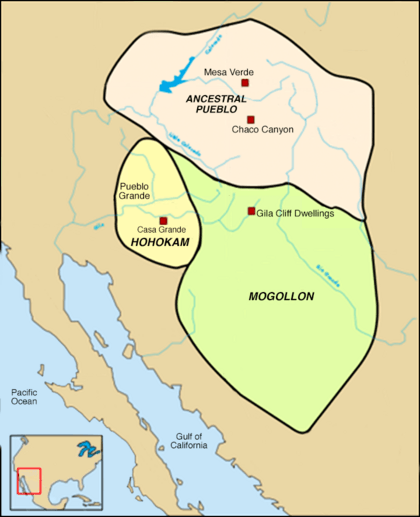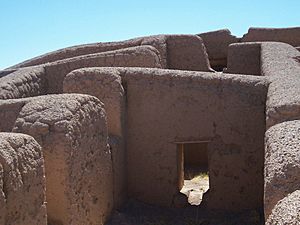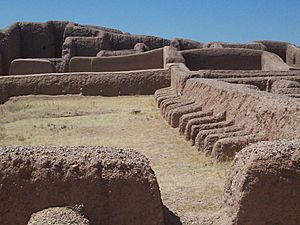Casas Grandes facts for kids
Quick facts for kids Casas Grandes |
|
|---|---|
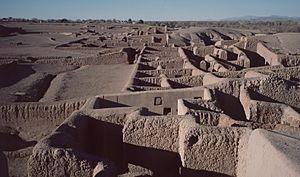
View of a section in Paquimé, Casas Grandes
|
|
| Location | Chihuahua, Mexico |
| Built | 1130 CE |
| Rebuilt | 1350 CE |
| Official name: Archaeological Zone of Paquimé, Casas Grandes | |
| Type | Cultural |
| Criteria | iii, iv |
| Designated | 1998 (22nd session) |
| Reference no. | 560rev |
| Region | Latin America and the Caribbean |
| Lua error in Module:Location_map at line 420: attempt to index field 'wikibase' (a nil value). | |
Casas Grandes (which means Great Houses in Spanish) is an ancient archaeological site in northern Mexico. It's also known as Paquimé. It's located in the state of Chihuahua. People from the Mogollon culture built this amazing place. Since 1998, UNESCO has called it a UNESCO World Heritage Site, which means it's super important to the world's history. It also became a "Pueblo Mágico" (Magical Town) in 2015.
Casas Grandes is one of the biggest and most interesting sites built by the Mogollon people. People started living here around 1130 AD. The larger buildings, which became multi-story homes, were built after 1350 AD. The community was left empty around 1450 AD. Casas Grandes is a very important place for understanding the Mogollon culture in northwestern Mexico. It shows how this culture connected with other sites in Arizona and New Mexico in the United States.
The Casas Grandes site is in a wide, fertile valley next to the Casas Grandes or San Miguel River. It's about 56 kilometers (35 miles) south of Janos. It's also about 240 kilometers (150 miles) northwest of Chihuahua, the state capital. The people living here used irrigation to water their farms.
The archaeological area is inside the modern municipality of Casas Grandes. Native groups have lived in this valley for thousands of years.
Contents
Life in Ancient Paquimé
Between 1130 and 1300 AD, people in this area started living together in small villages. These villages were in the large, fertile valley. The biggest village found is what we now call Paquimé or Casas Grandes. It began as more than 20 groups of houses. Each group had its own plaza (open square) and a wall around it. These homes were made of adobe (sun-dried mud bricks) and had one story. They all shared a single water system.
Archaeologists found that Paquimé had a very smart water system. It included underground drains and reservoirs to store water. Channels brought water to the houses, and there was even a sewage system.
Around 1340 AD, the site was partly burned. After this, Casas Grandes was rebuilt with taller apartment buildings. These replaced the smaller homes. The new Casas Grandes had about 2,000 rooms connected together. They were made of adobe. There were also "I-shaped" Mesoamerican ballcourts, stone platforms, and special mounds shaped like animals. There was even a market area.
About 350 other smaller villages have been found near Casas Grandes. Some were as far as 70 kilometers (43 miles) away. Experts think that Casas Grandes directly controlled an area about 30 kilometers (19 miles) around the city. The main city might have had about 2,500 people. Perhaps 10,000 people lived in the whole area it controlled.
Amazing Crafts and Trade
The people of Casas Grandes were skilled at making many things. They created copper bells and decorations. They also made a lot of pottery and beads from ocean molluscs (seashells). These special items were likely traded far and wide.
Casas Grandes pottery often has a white or reddish surface. It's decorated with designs in blue, red, brown, or black. Sometimes, these pots were shaped like human figures or animals. This pottery was traded to ancient people as far north as today's New Mexico and Arizona. It was also traded throughout northern Mexico.
Uncovering Ancient Ruins
When the Spanish arrived in the 1500s, the Casas Grandes area had many artificial mounds. People looking for treasures often found stone axes, metates (corn grinders), and different kinds of earthenware pots.
Before archaeologists started serious digs, large parts of the ancient buildings were still standing. These ruins were about 800 meters (half a mile) from the modern town. The buildings were made from sun-dried blocks of mud and gravel. These blocks were about 56 centimeters (22 inches) thick. They were usually about 0.9 meters (3 feet) long. The thick walls were probably covered with plaster inside and out.
One main building stretched 240 meters (800 feet) from north to south. It was 76 meters (250 feet) from east to west. It looked like a rectangle and seemed to have three separate parts. These parts were connected by hallways or lower buildings.
A stone wall and water reservoirs divided the city into eastern and western halves. The buildings on the east were straight, adobe structures. These were mostly used for homes and workshops. The buildings on the west were open earth mounds lined with stone. These were likely used for public events. This design shows influences from both the Puebloan cultures to the north and the Mesoamerican cultures to the south.
The homes at Paquimé included round and half-round pit houses. There were also adobe room blocks built around plazas. Living spaces varied a lot, from small closet-sized rooms to large courtyards. Some walls still stand 12 to 15 meters (40 to 50 feet) high. This suggests the buildings were once six or seven stories tall!
The settlement had T-shaped doorways and stone disks at the bottom of ceiling support columns. These are common in Puebloan architecture. Casas Grandes also had Mesoamerican ballcourts. They were smaller than some, but they had the classic "I" shape found in Mesoamerica. This is different from the oval-shaped courts found with the Hohokam culture in Arizona.
Archaeologists found a huge 2,268-kilogram (5,000-pound) iron meteorite in one room. It was carefully wrapped in cloth. This meteorite is now on display at the Smithsonian Museum of Natural History.
During digs, experts found pieces of eggshells, bird skeletons, and traces of wooden perches. There was also a row of special pens for macaws in the middle of the site. Archaeologists believe the community brought scarlet macaws from Mesoamerica. They raised these birds because their colorful feathers were very important in Mesoamerican ceremonies.
Many Casas Grandes pottery pieces are kept at the Museum of Peoples and Cultures in Utah. Stanford University in California also has artifacts. The British Museum in London bought 23 pottery vessels from the site in 1979. A new exhibit about Paquimé recently opened at the Amerind Museum. Most other items found at Paquimé are cared for by INAH in Chihuahua.
The ruins of Casas Grandes are similar to other ancient sites. These include places near Gila and Salinas in New Mexico, as well as sites in Arizona and Colorado. This suggests they were all part of or connected to the Mogollon culture.
Symbols and Meanings

Iconography means using pictures or symbols to represent ideas. At Casas Grandes, the symbols found have helped us understand how men and women lived. They show their daily tasks, trade, and religious practices.
Small figurines, called effigies, were found during excavations. These effigies clearly show differences between males and females. Their body positions, shapes, activities, and face decorations help archaeologists guess how gender roles were shown. The artists of Casas Grandes showed many behaviors and beliefs. These ranged from social rules (like how to sit) to religious activities (like smoking) and supernatural beings (like horned or feathered serpents).
Based on these effigies, archaeologists think that both women's and men's activities were valued. Social differences were more about a person's status or group than their gender. For example, male figures often sat with their legs bent close to their bodies. They were decorated with special symbols and horned serpent images. They were sometimes shown smoking. Female figures often had larger midsections and sat with their legs stretched out. They were decorated with bird images and were shown holding children or pots, sometimes even nursing. These effigies give us clues about how the Casas Grandes people saw social life and gender roles.
The Mystery of Paquimé's End
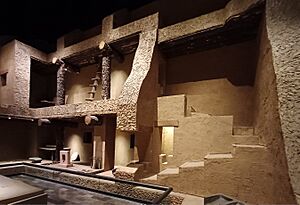
Many ideas exist about who the people of Casas Grandes were. Most experts agree that the site is part of the Mogollon culture. This is because it's connected to other sites like Forty Houses, 60 miles (97 km) south, and TJ Ruins and Gila Cliff, 200 miles (322 km) north.
There are a few theories about why Casas Grandes existed. One idea is that it was a quiet place until about 1200 CE. Then, traders from the Aztec empire or other southern Mesoamerican states turned it into a big trading hub. Another idea is the opposite: that important leaders from the Ancestral Puebloans in the north, who were leaving places like Chaco Canyon, started Casas Grandes.
A third theory is that Casas Grandes grew purely from local people. They slowly became powerful in their region. They then adopted some religious and social customs from the Mesoamerican civilizations. Most experts agree that trade happened between the cultures of Mesoamerica, Aridoamerica, and the American Southwest. However, it wasn't a huge, planned trading system.
Casas Grandes was abandoned around 1450 AD. It's not clear if people left slowly over many years or all at once. The Spanish explorer Francisco de Ibarra found the site in 1565. Local Suma or Jano people told him that a war with the Opata people caused the abandonment. They said the inhabitants moved north. This story suggests the people of Casas Grandes might have joined the Pueblos along the Rio Grande in New Mexico.
Other ideas suggest the Casas Grandes people moved west to Sonora. There, they might have joined or become the Opata people. It's also possible that people left Casas Grandes because they found better opportunities elsewhere. Other ancient communities in the Southwest are known to have been abandoned for new homes.
We don't know what language the people of Casas Grandes spoke. Because of the Mesoamerican influence, Nahuatl might have been spoken by some, but it probably wasn't the main language of everyone.
See also
 In Spanish: Paquimé para niños
In Spanish: Paquimé para niños
- Colonia Dublán
- Cuarenta Casas
- Cueva de la Olla
- Gila Cliff Dwellings National Monument
- Mata Ortiz pottery
- Mogollon culture
- Nuevo Casas Grandes
- Oasisamerica
- PreColumbian cultural divisions of northern Mexico and southwestern United States
Images for kids


